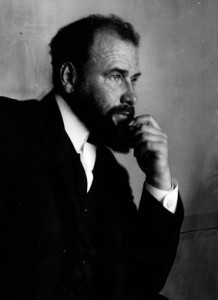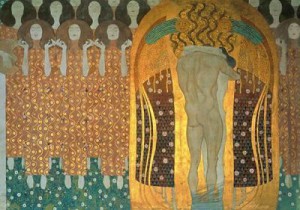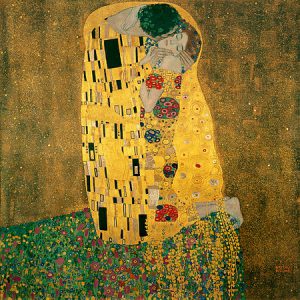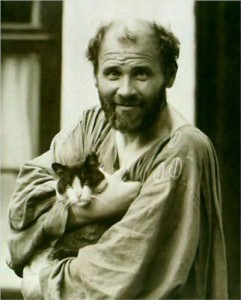Gustav Klimt: A pioneer of artistic vision in Vienna
By Tracy A. Burns
 A pioneer of artistic individuality, Austrian symbolist painter Gustav Klimt promoted the Viennese Secession movement, in which he took part for more than 10 years. His unique style is in part rendered by golden ornamentation and a sensual portrayal of erotic figures. Yet he also drew numerous sketches and painted murals, mosaics, landscapes, and portraits. To be sure, the name Gustav Klimt is intricately tied to the history of Vienna, his hometown. His works convey the tension apparent at the end of the 19th century and the beginning of the 20th century when the powerful Habsburg Monarchy was decaying due to nationalistic tendencies.
A pioneer of artistic individuality, Austrian symbolist painter Gustav Klimt promoted the Viennese Secession movement, in which he took part for more than 10 years. His unique style is in part rendered by golden ornamentation and a sensual portrayal of erotic figures. Yet he also drew numerous sketches and painted murals, mosaics, landscapes, and portraits. To be sure, the name Gustav Klimt is intricately tied to the history of Vienna, his hometown. His works convey the tension apparent at the end of the 19th century and the beginning of the 20th century when the powerful Habsburg Monarchy was decaying due to nationalistic tendencies.
Early years
Born near Vienna on July 14, 1862, to a mother who had musical aspirations and a Bohemian father who was a gold engraver, Gustav Klimt grew up in Austro-Hungary as the Habsburg Monarchy dominated the political scene. The second of seven children, Klimt earned a scholarship to attend the Vienna School of Arts and Crafts when he was 14 years old. There he learned how to create frescoes, murals, and paintings.
The Company of Artists
Shortly thereafter his brother Ernst, also blessed with artistic talent, entered the school. Along with friend Franz Matsch, the brothers formed the Company of Artists in 1879 and received many commissions during their 10 years of existence. Klimt’s early work was very academic and traditional. It was only in 1896 that he began to take risks by portraying the human body in a sensual and sexual manner. Most of the group’s early work focused on large public buildings – they decorated a spa building in Bohemian Karlovy Vary, the Kunsthistoriches Museum, and the Burgtheater in Vienna, for instance.
Recognition, awards
In 1888 Klimt received the Golden Order of Merit from Emperor Franz Joseph I in recognition of his artistic expertise on murals in the Burgtheater. In 1895 he was awarded the Antwerp Grand Prize for his decorations at a chateau in Totis, Hungary. He also was made an honorary member of the University of Vienna and the University of Munich.
Coping with deaths and meeting Emilie
In the early 1890s fate intervened. Klimt’s brother and father died, and he met Emilie Louise Flöge, the sister of his sister-in-law, who became his lifelong companion, though they never lived together. He had 14 children, mostly with his models who sometimes also worked as prostitutes. Though he was known as a womanizer, he kept his affairs discreet and rarely socialized. Klimt’s letters to Flöge are bland, lacking any hint of emotional ties or passion.
The University of Vienna commission
In 1894 his three paintings of “Philosophy,” “Medicine” and “Jurisprudence” on the ceiling of the Great Hall in the University of Vienna triggered an outcry as critics declared that the sexual female beauties qualified as pornography. He was forced to withdraw the paintings. Still, in 1900 “Philosophy” received a gold medal at the World Fair in Paris.
Founding the Viennese Secession
One of the founders of the Viennese Secession style and its periodical Ver Sacrum (Sacred Spring) in 1897, Klimt aspired to show off daring works by young artists in the group and to put artistic creations by foreigners on display as well. He would stay with the group until 1908.
Klimt’s style
The movement did not have a specific style, but Klimt’s productions were totally different than his earlier, academic ones. He manipulated space so that it was flattened onto a single plane in two dimensions and used gold ornamentation, inspired by Japanese art, early Egyptian imagery, Byzantine art and works from Ravenna, Italy. His works boasted of expressive lines, geometric shapes, and spirals. They are punctuated by a mystical quality and are very stylized. His use of Oriental colors brings to mind decadence and eroticism. Klimt often drew women masturbating, and men usually have their backs to the viewer in his sketches. The women in his creations sport long, flowing hair and exude sexual confidence. Their bodies are lean and curvy. The female figures appear alluring and threatening, even mysterious.
The Beethoven Frieze
 Created for the 14th exhibition of the Association of Visual Artists – Vienna Secession in 1902 and considered one of the premiere examples of Viennese Secession, the Beethoven Frieze was inspired by Richard Wagner’s interpretation of Beethoven’s Ninth Symphony. Painted on the walls of Vienna’s Secession House, it recounts humankind’s quest for happiness. Take a close look at the painting’s narrow wall. It is divided into the sections “Hostile Forces,” “Gorgons” and “Typhoeus,” a shaggy, blue-winged giant with a body reminiscent of a snake. His pearl-like eyes capture the viewer’s full attention. Do not overlook the snakes slivering through the hair of the three Gorgons, who are the giant’s daughters. The upper class was shocked by this work, in which Gluttony was viewed as an obese man with large breasts.
Created for the 14th exhibition of the Association of Visual Artists – Vienna Secession in 1902 and considered one of the premiere examples of Viennese Secession, the Beethoven Frieze was inspired by Richard Wagner’s interpretation of Beethoven’s Ninth Symphony. Painted on the walls of Vienna’s Secession House, it recounts humankind’s quest for happiness. Take a close look at the painting’s narrow wall. It is divided into the sections “Hostile Forces,” “Gorgons” and “Typhoeus,” a shaggy, blue-winged giant with a body reminiscent of a snake. His pearl-like eyes capture the viewer’s full attention. Do not overlook the snakes slivering through the hair of the three Gorgons, who are the giant’s daughters. The upper class was shocked by this work, in which Gluttony was viewed as an obese man with large breasts.
The Kiss
 The Kiss, created in 1907 and 1908, was inspired by gold leaf decoration stemming from the Bronze Age and by flat Byzantine mosaics like those Klimt had seen in Ravenna. The opulence and golden brilliance trigger feelings of decadence. Some people thought that the work showed Klimt and Flöge as lovers. It expresses fulfillment through the power of love by utilizing imagery about birth and death as well as desire and fulfillment. In this painting, two bodies are intertwined. The man dons a robe with a gold leaf and spiral pattern while the woman wears a floral dress and flowers in her hair. The man’s face is hidden from the viewer as he holds the woman, his hands on her face. Yet the woman appears shy. Instead of succumbing to his embrace, she coils back from him as her hands appear to push him away. The kiss winds up being a peck on the cheek. The painting is now on display in Vienna’s Upper Belvedere Palace.
The Kiss, created in 1907 and 1908, was inspired by gold leaf decoration stemming from the Bronze Age and by flat Byzantine mosaics like those Klimt had seen in Ravenna. The opulence and golden brilliance trigger feelings of decadence. Some people thought that the work showed Klimt and Flöge as lovers. It expresses fulfillment through the power of love by utilizing imagery about birth and death as well as desire and fulfillment. In this painting, two bodies are intertwined. The man dons a robe with a gold leaf and spiral pattern while the woman wears a floral dress and flowers in her hair. The man’s face is hidden from the viewer as he holds the woman, his hands on her face. Yet the woman appears shy. Instead of succumbing to his embrace, she coils back from him as her hands appear to push him away. The kiss winds up being a peck on the cheek. The painting is now on display in Vienna’s Upper Belvedere Palace.
Portraits, landscapes, and more
Klimt was a skilled portrait painter, which is how he earned his livelihood. He painted women wrapped in fur or naked, women in motion or seated, women lying down or standing. The stunning dresses worn by some subjects blend into the background while the faces are rendered with distinctive loneliness and fragility. His portraits of high-society ladies revealed the sitters’ personalities, although the women also served as an iconic embodiment of his adulation for the female body. From 1897 he spent every summer with the Flöge family in the village of Attersee, where he devoted his time to landscapes. These paintings make up a quarter of his total work. In After the Rain from 1898 he depicts delicate pink flowers in a field. Other notable landscapes include Flowering Poppies from 1907, Sunflower from 1907, and Cottage Garden with Sunflowers from 1908. He was also one of the artists who decorated the Stoclet Palace, one of the best Art Nouveau architectural works, which served as home to a wealthy Belgian industrialist. His mosaic friezes can be seen in the dining room of the palace designed by architect Josef Hoffmann.
Death of an old order
In 1915 Klimt’s mother died. Three years later, on January 11, 1918, Klimt suffered a seizure that paralyzed half his body. He died on February 6. That same year painter Egon Schiele, also prominent in the Vienna circle and another bright light of Mitteleuropa, passed away, too. The Habsburg Monarchy was abolished in 1918 to make way for new nation-states, such as Czechoslovakia. With Gustav Klimt, the entire old order seemed to die. The provocative painter is buried at Hietzinger Cemetery in Heitzing, Vienna.
Legacy
 Klimt left about 250 paintings and 3,000 drawings. Many of his paintings can be seen in the Upper Belvedere Palace, Leopold Museum, and Albertina in Vienna while the Beethoven Frieze basks in the Secession Building. A plethora of his drawings exists at the Vienna Museum. His works are now worth a fortune. In 2006, the 1907 portrait Adele Bloch-Bauer I was bought for the Neue Galerie New York at the price of 135 million US dollars, then the highest ever reported price paid for a painting. That same year his Portrait of Adele Block-Bauer II sold for 88 million.
Klimt left about 250 paintings and 3,000 drawings. Many of his paintings can be seen in the Upper Belvedere Palace, Leopold Museum, and Albertina in Vienna while the Beethoven Frieze basks in the Secession Building. A plethora of his drawings exists at the Vienna Museum. His works are now worth a fortune. In 2006, the 1907 portrait Adele Bloch-Bauer I was bought for the Neue Galerie New York at the price of 135 million US dollars, then the highest ever reported price paid for a painting. That same year his Portrait of Adele Block-Bauer II sold for 88 million.



